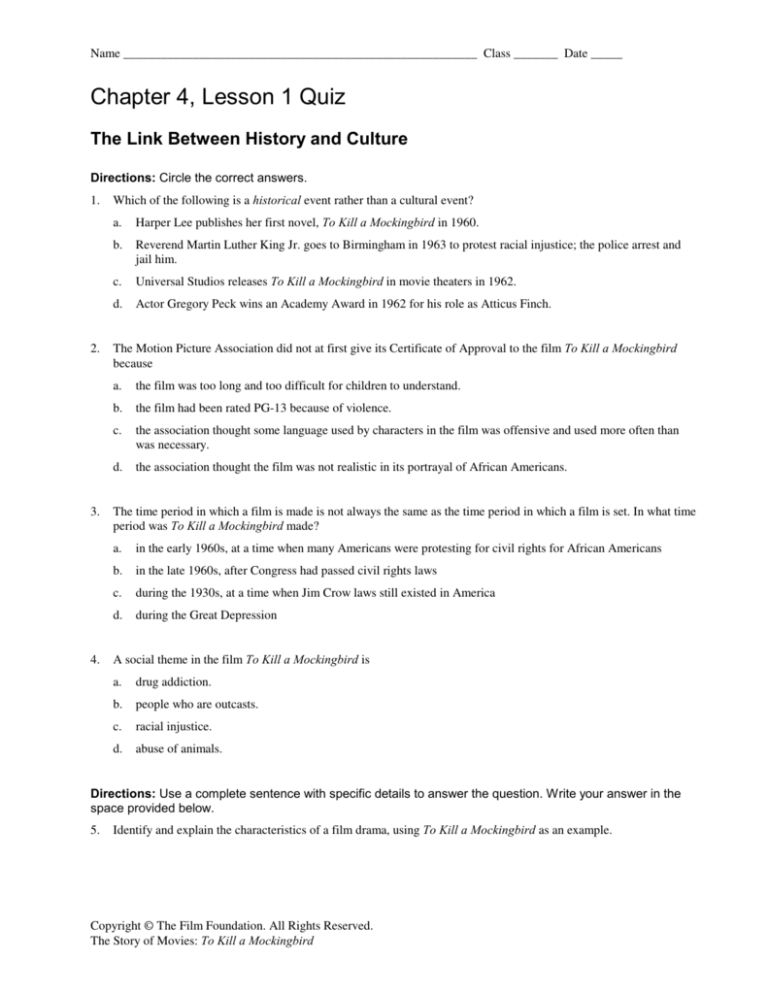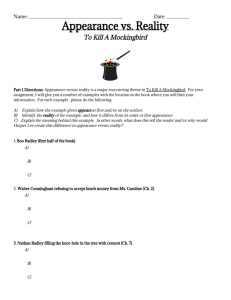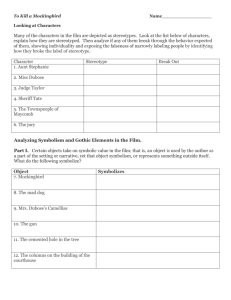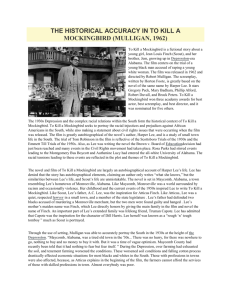
Name ________________________________________________________ Class _______ Date _____
Chapter 4, Lesson 1 Quiz
The Link Between History and Culture
Directions: Circle the correct answers.
1.
2.
3.
4.
Which of the following is a historical event rather than a cultural event?
a.
Harper Lee publishes her first novel, To Kill a Mockingbird in 1960.
b.
Reverend Martin Luther King Jr. goes to Birmingham in 1963 to protest racial injustice; the police arrest and
jail him.
c.
Universal Studios releases To Kill a Mockingbird in movie theaters in 1962.
d.
Actor Gregory Peck wins an Academy Award in 1962 for his role as Atticus Finch.
The Motion Picture Association did not at first give its Certificate of Approval to the film To Kill a Mockingbird
because
a.
the film was too long and too difficult for children to understand.
b.
the film had been rated PG-13 because of violence.
c.
the association thought some language used by characters in the film was offensive and used more often than
was necessary.
d.
the association thought the film was not realistic in its portrayal of African Americans.
The time period in which a film is made is not always the same as the time period in which a film is set. In what time
period was To Kill a Mockingbird made?
a.
in the early 1960s, at a time when many Americans were protesting for civil rights for African Americans
b.
in the late 1960s, after Congress had passed civil rights laws
c.
during the 1930s, at a time when Jim Crow laws still existed in America
d.
during the Great Depression
A social theme in the film To Kill a Mockingbird is
a.
drug addiction.
b.
people who are outcasts.
c.
racial injustice.
d.
abuse of animals.
Directions: Use a complete sentence with specific details to answer the question. Write your answer in the
space provided below.
5.
Identify and explain the characteristics of a film drama, using To Kill a Mockingbird as an example.
Copyright © The Film Foundation. All Rights Reserved.
The Story of Movies: To Kill a Mockingbird
Name ________________________________________________________ Class _______ Date _____
Chapter 4, Lesson 2 Quiz
Civil Rights Issues, 1930s and 1960s
Directions: Answer each question by writing T if the statement is true, or F is the statement is false. Write
your answers on the lines provided.
_____
1. During the period in which the film is set, lynching was not a social problem in America.
_____
2. During the period in which the film was made, lynching was not a social problem.
_____
3. Jim Crow laws no longer existed during the period in which the film To Kill a Mockingbird was made.
_____
4. The film To Kill a Mockingbird reflects the racial conflicts of not only the 1930s but also the 1960s.
Directions: Use a complete sentence with specific details to answer the question. Write your answer in the
space provided below.
5.
Explain in your own words why the mob scene outside the jail where Tom Robinson is being held is relevant to
social issues of the 1930s. Cite an example from the materials studied in this lesson to support your answer.
Copyright © The Film Foundation. All Rights Reserved.
The Story of Movies: To Kill a Mockingbird
Name ________________________________________________________ Class _______ Date _____
Chapter 4, Lesson 3 Quiz
Analyzing Film Depictions
Directions: Circle the correct answers.
1. A fact is always true, but a depiction is
a.
always false.
b.
always based on historical evidence.
c.
someone’s interpretation of a person, a place, or an event.
d.
a visual symbol.
2. A type of shot that emphasizes dramatic impact and usually records a character’s surprise or lack of surprise, fear or
lack of fear, is called
3.
4.
a.
a key shot
b.
a depiction
c.
the point of emphasis
d.
a reaction shot
What methods do the filmmakers use to depict Tom Robinson’s character as innocent and noble?
a.
Tom Robinson only speaks when spoken to.
b.
The camera provides close-ups of Tom Robinson’s face during his testimony, showing his tears and dignity.
c.
Tom Robinson is frightened inside the jail while Atticus protects him from the mob.
d.
Robinson wears overalls during his court trial.
A visual or sound image that emphasizes the unfavorable qualities of a person or place is a
a.
negative depiction.
b.
positive depiction.
c.
connotation.
d.
reaction shot.
Directions: Use a complete sentence with specific details to answer the question. Write your answer in the
space provided below.
5.
Select either a negative or a positive depiction of a character in the film and explain what techniques the filmmaker
used to show this character in this particular way.
Note: Lesson 4’s writing activity does not have a quiz.
Copyright © The Film Foundation. All Rights Reserved.
The Story of Movies: To Kill a Mockingbird






